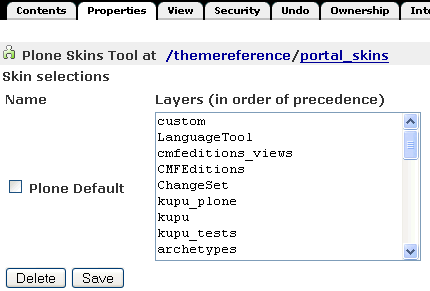Customizing through Order of Precedence¶
How skin layers work and how they can be used in customization.
If you've worked with Plone 2, you'll be familiar with this type of customization. As we mentioned earlier, the order of layers in a skin determines which page templates, CSS files and Python scripts are processed first.
To inspect the order of precedence:
- Site > Zope Management Interface > portal_skins
- click the Properties tab
You should see the layers of the Plone Default skin listed there. Layers such as 'plone_templates' come from the main Plone theme but there will also be layers providing templates from specific add-on products (the visual editor kupu for instance).
 When asked to process a specific template, Plone will work
from the top of this list downwards, looking in each layer
in turn to retrieve the template.
When asked to process a specific template, Plone will work
from the top of this list downwards, looking in each layer
in turn to retrieve the template.
At the top is a custom layer; any template placed in here will be found and used first. So, to create your own version of a Plone template or CSS file, give it the same name as the Plone version but put it in the custom layer.
This is the simplest approach, but just ensuring that your version lives in a layer higher in the order of precedence in a skin than the main Plone theme layers will be enough to ensure that Plone finds it first and ignores the original version.
This technique can be used in two ways
- using the custom folder
- through the Zope Management Interface, you can add your own versions of templates, style sheets etc to the custom folder. This always comes at the top, so you can be sure your versions will be found first.
- adding your own skin layers
- in your own theme product on the file system, create one or two skin layers, and ensure that on installation these layers are put just below the custom folder in the order or precedence. There's more information on how to do this in the next section.
Probably the most comprehensive description of skins, layers and order or precedence can be found in the first two sections of Chapter 7 of The Definitive Guide to Plone (note that most of this book refers to Plone 2, but these sections are still relevant for Plone 3).
